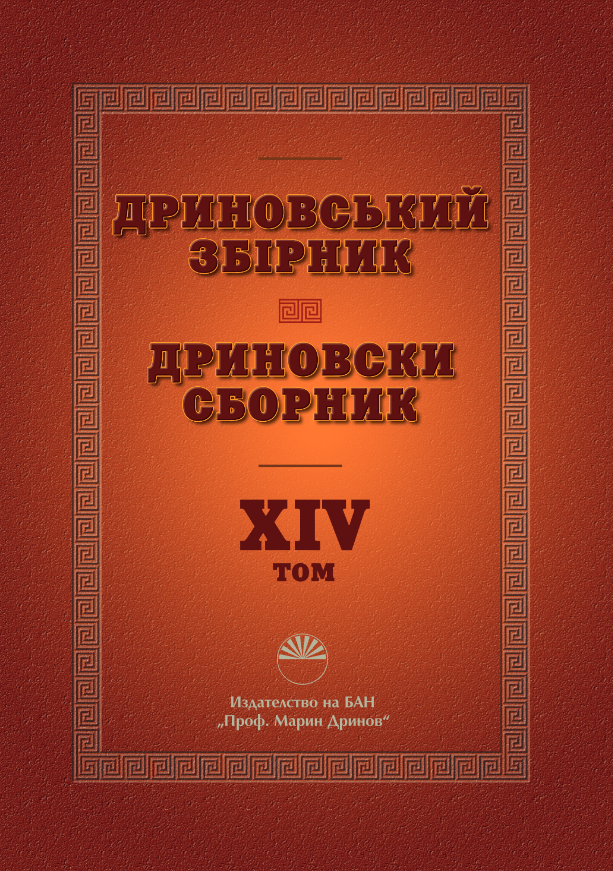Infrastructure of the Balkans in the 19th century and its influence on the fate of the Bulgarians
Анотація
The infrastructure, or the combination of topography and of technology, plays significant role in the economic and cultural development of every nation. Beside, the favorable political environment influences the development, as well. However, there were no such favorable conditions in the Bulgarian lands in the 19th centuries since from the 14th century onwards they were included in the domains and the public structures of the Ottoman Empire, a kind of rule or an alien yoke which was based on the sharia law. Economically underdeveloped, the Ottoman Empire prevented the headway of the Bulgarians for centuries long. In contrast to the industrial progress of the free European countries the Bulgarian lands of the 19th century were prevailed by different handcrafts and workshops which were poorly equipped. Just 15 years after 1878, or after the reestablishment of the Bulgaria on the world map, the country reached the economical status of the neighbor states and even surpassed them in some branches. At the beginning of 20th century the economic development of Bulgaria rapidly went on, but it was stopped by the Balkan wars of 1912-1913 and the First World War of 1914-1918.
Завантаження
Посилання
Dimitrov, A. 1987. Uchilishteto, progresat i natsionanata revolyutsia. Bulgarskite uchilishta prez Vazrazhdaneto [The school progress and the national revolution. The Bulgarian schools during the Revival]. Sofia. (In Bulgarian).
Dimitrov, Str. 1962. Za agrarnite otnoshenia v Bulgaria prez ХVІІІ v. [On agrarian relations in Bulgaria in the 18th century]. Paisiy Hilendarski i negovata epoha [Paisii Hilendarski and his epoch] Sofia, s. 129-165. (In Bulgarian)
Genov, Kr. 1962. „Ribniyat bukvar“ na Beron i „Eklogarat“ na Darvaris [Beron's Fish Primer and Darvaris's Eclogar], Narodna prosveta, part 7, s. 64-74. (In Bulgarian)
Grabar, A. 1938. Boyanskata tsarkva [The Boyana Church]. Sofia. (In Bulgarian).
Hristov, Hr. A. 1962. Paisiy Hilendarski i Balgarskoto vazrazhdane. [Paisii Hilendarski and the Bulgarian Revival]. Paisiy Hilendarski i negovata epoha [Paisii Hilendarski and his epoch]. Sofia, s. 13–69. (In Bulgarian)
Hristov, Hr. 1968. Osvobozhdenieto na Bulgaria i politikata na zapadnite darzhavi 1876-1878 [The liberation of Bulgaria and the policy of the western countries 1876-1878]. Sofia. (In Bulgarian)
Kovachev, M. 1967. Balgarskoto monashestvo v Aton. [Bulgarian monasticism in Mount Athos] Sofia. (In Bulgarian)
Markova, Z. 1999. Balgarskata ekzarhia 1870-1879 [The Bulgarian Exarchate 1870-1879]. Sofia. (In Bulgarian)
Markova, Z. 1976. Balgarskoto natsionalno tsarkovno dvizhenie do Krimskata voyna [The Bulgarian National Church Movement until the Crimean War] Sofia. (In Bulgarian)
Mavrodinov, N. 1943. Boyanskata tsarkva i neynite stenopisi [The Boyana Church and its Murals]. Sofia. (In Bulgarian).
Miyatev, Kr. 1961 еt al. Boyanskite stenopisi. [The Boyana murals]. Sofia. (In Bulgarian).
Mihaylov, St. 1960. Boyanskata tsarkva – belezhit pametnik na srednovekovnoto balgarsko izkustvo [Boyana Church – a landmark monument of medieval Bulgarian art]. Archeology, Sofia, part 2, s. 1-13. (In Bulgarian).
Mutafchieva, V еt al. 1999. Kniga za Sofroniy Vrachanski [A book about Sophrony of Vratsa]. Sofia. (In Bulgarian)
Nachov, N. 1925. Tsarigrad kato kulturen tsentar na balgarite do 1877 [Constantinople as a cultural center of the Bulgarians until 1877]. Sofia. (In Bulgarian)
Nikov, P. 1971. Vazrazhdane na balgarskia narod. Tsarkovno-natsionalni borbi i postizhenia [Revival of the Bulgarian people. Church-national struggles and achievements]. Sofia, 2nd ed. (In Bulgarian)
Petar Beron 1962. Izsledvania i materiali [Peter Beron. Research and materials]. Sofia. (In Bulgarian)
Sabev, T. 1972. Uchredyavane i diotsez na Balgarskata ekzarhia do 1878 g. [Establishment and diocese of the Bulgarian Exarchate until 1878]. Sofia. (In Bulgarian)
Sharova, K. 2007. BRTsK i Protsesat sled Arabakonashkoto napadenie 1872-1873 [BRCC and the Trial after the Arabakon Attack of 1872-1873]. Sofia. (In Bulgarian)
Siromahova, Zh. et al. 1964. Ikonomicheskoto razvitie na Ruse prez Vazrazhdaneto [The economic development of Ruse during the Revival] Izvestia na Narodnia muzey – Ruse [Bulletin of the National Museum – Ruse], s. 14-49. (In Bulgarian)
Tarnovskata knizhovna shkola, 1974-1985 [Tarnovo Literary School]. Sofia, vol. 1–4. (In Bulgarian).
Traykov, V. 1974. Georgi Stoykov Rakovski. Biografia [Georgi Stoykov Rakovski. Biography]. Sofia. (In Bulgarian).
Tsvetkova, B. 1955. Turskiyat feodalizam i polozhenieto na balgarskite zemi do nachaloto na ХІХ v. [Turkish feudalism and the situation of the Bulgarian lands until the beginning of the XIX century]. Historical Review. Sofia, part 1, s. 59–86. (In Bulgarian).
Zhekov, P. 1929. „Parvata balgarska suknena fabrika“ ["The first Bulgarian cloth factory"] Yubileen sbornik na Balgarskoto narodno chitalishte „Zora“ v Sliven, [Jubilee collection of the Bulgarian National Chitalishte "Zora" in Sliven] Sofia, s. 222-224. (In Bulgarian).
Zlatarski, V. N. 1900. Predgovor kam knigata na yeroshimonyah Spiridon. [Preface to the book of hieroschimonach Spiridon] Yeroshimonyah Spiridon. Istoria vo krattse o bolgarskom narode slovenskom [Hieroschimonach Spiridon. A short story about the Bulgarian Slovenian people]. Sofia, s. 5–102. (In Bulgarian)

